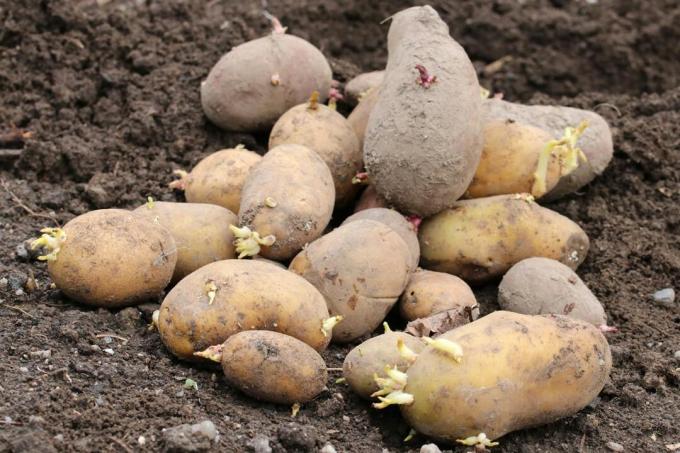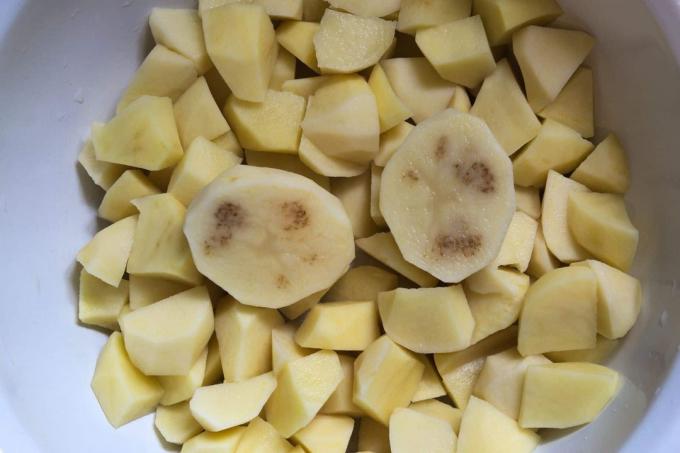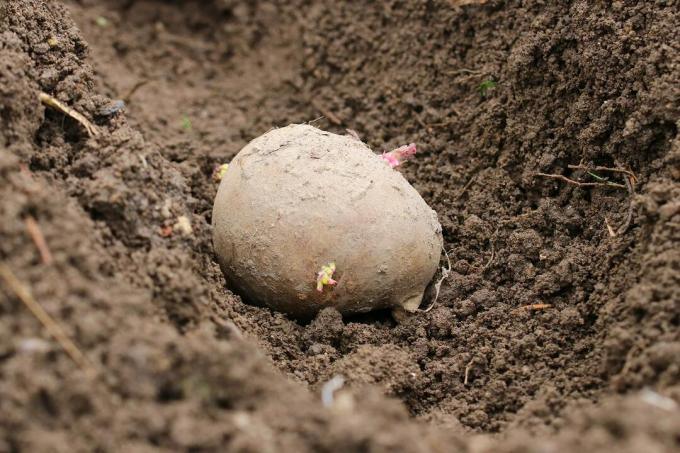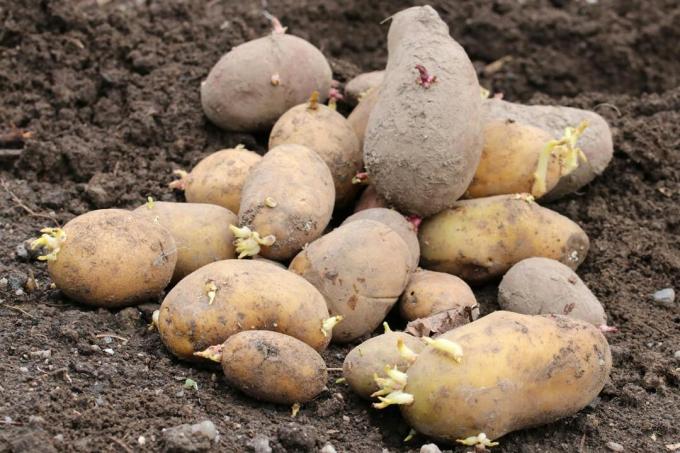

Table of contents
- Create optimal planting conditions
- planting time
- Let the potatoes sprout
- distance and depth
- After planting
- Planting in the bucket
- Seed potatoes or ware potatoes?
There is a large selection of potato varieties. Irrespective of this, you can harvest ten to fifteen times as many tubers from a planted potato as long as you observe a few basic things when planting.
Create optimal planting conditions
Potatoes, also known as potatoes, need humus-rich, well-drained, light to medium-heavy soil. They do not tolerate waterlogging, such as occurs in heavy clay soil, unless treated with sand and compost. Sandy soils are particularly suitable.
- Preculture with deep-rooted vegetables can be useful
- Potato has high nutrient requirements, heavy feeder
- ideally incorporate compost into soil in early spring
- or spread manure on the field in the autumn of the previous year
- Thoroughly loosen the soil before planting
- to a depth of approx. 30 cm
- Remove root remains, weeds and stones
- Pay attention to crop rotation when planting potatoes
- Tubers should be first culture on the plot
Potatoes are the best vegetables when it comes to making the soil arable. However, they are incompatible with themselves and should therefore not be grown again at the same location for at least four years. Planting in the immediate vicinity of tomatoes is also unfavorable, as this could promote the transmission of the dreaded late blight.
Tip:
Compost should not be incorporated into the soil immediately prior to planting. Otherwise, over-fertilization could be the result, which in turn affects the taste and storability of the tubers.
planting time
The right time for planting depends on the region or region. depending on the prevailing climatic conditions and the respective variety. Depending on whether the potatoes are early, medium early or late varieties. Basically, they should not be planted too early, because the tubers are sensitive to frost. The ground should already have warmed up to about ten degrees. Early varieties can be planted when temperatures during the day no longer fall below ten degrees, around March or April. Mid-early and late follow from mid-April to mid-May.

Let the potatoes sprout
If you want to harvest the delicious tubers early, you have the option of letting them germinate from the end of February/beginning of March, about six weeks before planting. This means you can harvest about three weeks earlier. Pre-germination is suitable for early potatoes as well as for mid-early and late varieties.
- A box is filled with commercially available potting soil
- then put medium-sized tubers of the respective variety on the ground
- cover halfway with soil
- Place the box in a bright, 15 degree warm place
- for example in the conservatory or a greenhouse
- Tubers now need a lot of light
- within a few weeks, formation of short, strong shoots
- Plant out after about six weeks in the bed
distance and depth
To ensure that the rows of plants run as straight as possible, it is best to stretch a guide line. Furrows are then made in the ground along the cord with the handle of a hoe or similar device. They should have a depth of 10-20 cm. The distance between the rows should be at least 50 cm, better 70-80 cm. If the soil has not yet been fertilized, you can put some horn meal or horn shavings in the furrows.
Then you press the tubers lightly into the ground in such a way that the existing germ points upwards. But be careful, the sprouts break off very easily. Place early potatoes 30 cm apart, mid-early and late ones up to 60 cm apart. The furrows are then closed with a rake so that the tubers are completely covered with soil. Watering is not necessary when planting potatoes. Covering new potatoes with garden fleece can make sense at first, depending on the weather.
Tip:
Particularly large tubers can also be divided and each section planted. But then each of these sections should have at least one eye. This is also useful if you only have a few tubers available.
After planting
As soon as the first green shoots stick their heads out of the ground and are about 20 cm high, earthing up is the order of the day. This step should on the one hand increase the yield and on the other hand prevent the daughter tubers from growing out of the soil and being exposed to the light. This would cause them to turn green and become inedible because the green parts contain the poison solanine.

When piling up, the soil is pulled up to the potato plants with a field hoe or a rake so that they are about half covered with soil. New roots with additional tubers form under the mound. This process must be repeated at intervals of about two to three weeks. Care must be taken not to injure the herb.
Planting in the bucket
Potatoes can also be grown on the balcony in a very space-saving way, for example in special potato pots. Of course, you can also cultivate them in conventional large pots, in so-called plant bags or plant towers. Plant towers offer particularly good yields. The respective bucket should above all be high, dark-walled and made of plastic. Dark-walled because the soil in the pot warms up better when exposed to sunlight. Sufficient drainage holes in the bottom of the pot are essential.
- put a drainage about ten centimeters thick on the bottom of the pot
- for example from gravel or expanded clay
- then an approx. 15 cm thick layer of loose compost soil
- mix with sand if necessary
- on the ground with an appropriate distance, place the germinated tubers
- depending on the pot size about three to four
- then a layer of soil on the tubers
- when the green shoots are about 15 cm long, pile them up
Tip:
It is best to always pile up specimens in the pot in the evening. Then the leaves are usually directed upwards, so that you cannot damage them so easily.
Seed potatoes or ware potatoes?
Both special seed potatoes and normal ware potatoes are suitable for growing potatoes. Potatoes designated as seed potatoes have the advantage that they are always of the same variety. So the variety you bought also grows. They are usually available in all varieties.
Conventional ware potatoes are usually not so productive. If you use them again next year for sticking, the plants usually grow weaker and are much more susceptible to diseases. In addition, ware potatoes are often treated with sprout inhibitors, which not only prevents germination, but also severely impairs their ability to be stored.
Treated potatoes must be labeled accordingly. You are on the safe side if you pay attention to untreated tubers when buying. They are usually treated neither with germ protection agents nor with chemical pesticides. The tubers to be planted should be large and have multiple eyes. Then you can get good results.
 garden editorial
garden editorial I write about everything that interests me in my garden.
Learn more about potatoes

Potato is brown inside: is it edible?
After peeling or cooking, a potato has brown to black spots on the inside. This doesn't look very appetizing at first. And above all, the question arises as to whether the potato is still suitable for consumption or not. Since the causes of this discoloration can vary, in some cases it is due to […]

Black spots on potatoes: still use them?
Potatoes can have black spots. The potatoes are almost always edible despite the black spots. However, affected potatoes may show changes in taste and texture.

Time: from and until when do you plant potatoes?
Potatoes are among the most widely grown vegetables. So that self-cultivation works and a lush harvest can be brought in over many months, self-cultivators should pay attention to one important point: the right time to plant.

Mixed culture: 14 good neighbors of potatoes
German cuisine would be unthinkable without potatoes. Have you ever thought about growing the delicious tubers in your own garden? Use the advantages of a mixed culture! We present 14 plants that are suitable for mixed cultivation with potatoes.

Laying potatoes: ideal spacing and depth
Potatoes are good for the vegetable garden because they prepare the soil optimally for subsequent vegetables. They can also be stored for a long time and can be prepared in a variety of ways. You can read here which spacing is the right one for laying potatoes.

Storing & Cellaring Potatoes | 10 tips for storing potatoes
The potato is one of the most traditional vegetables in this country and can hardly be surpassed in terms of culinary variety. Anyone who grows them in their own garden can benefit from a huge variety of varieties and, if stored appropriately, can benefit from them for a long time.



